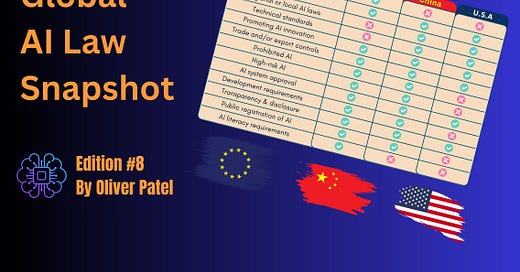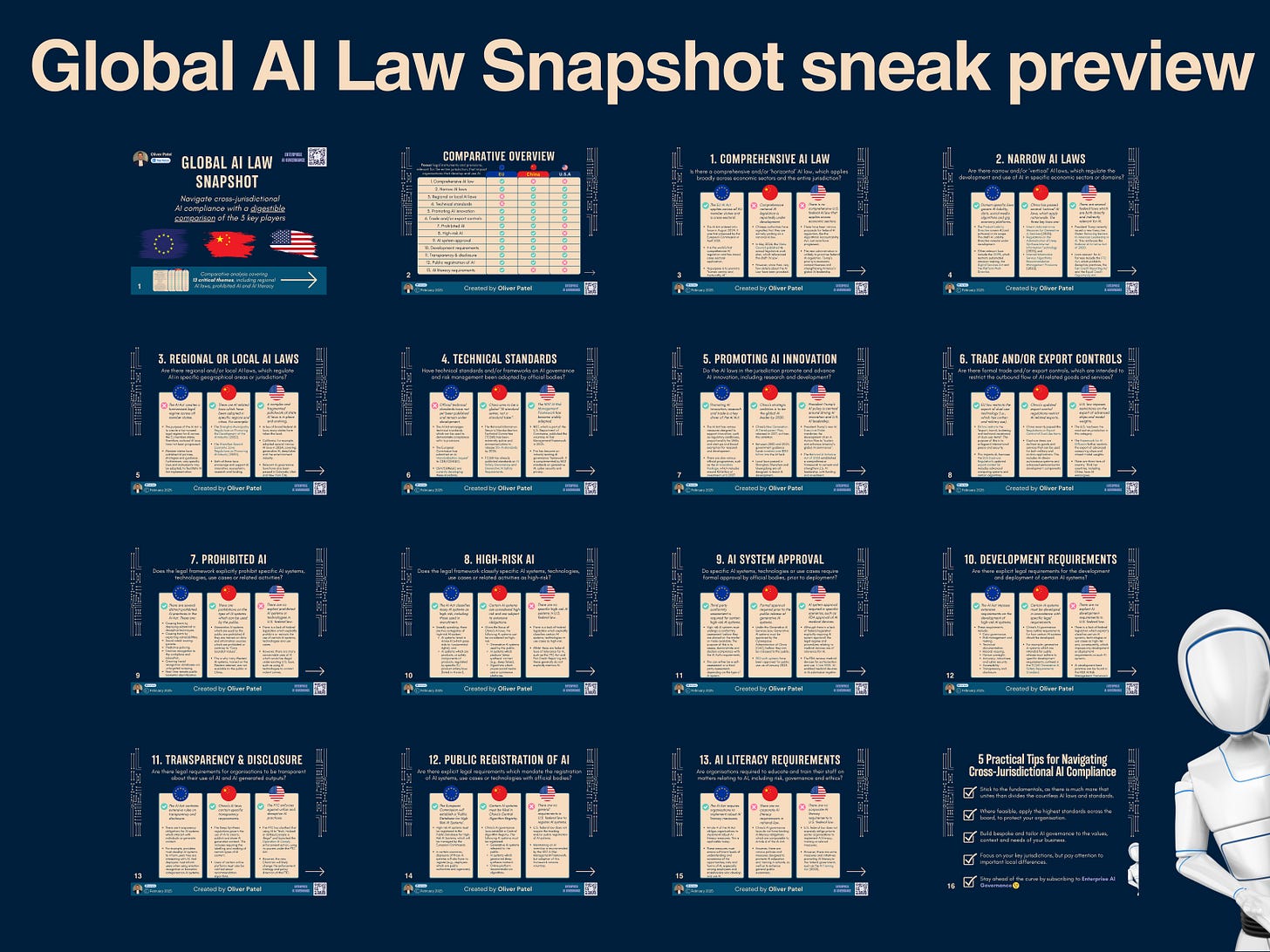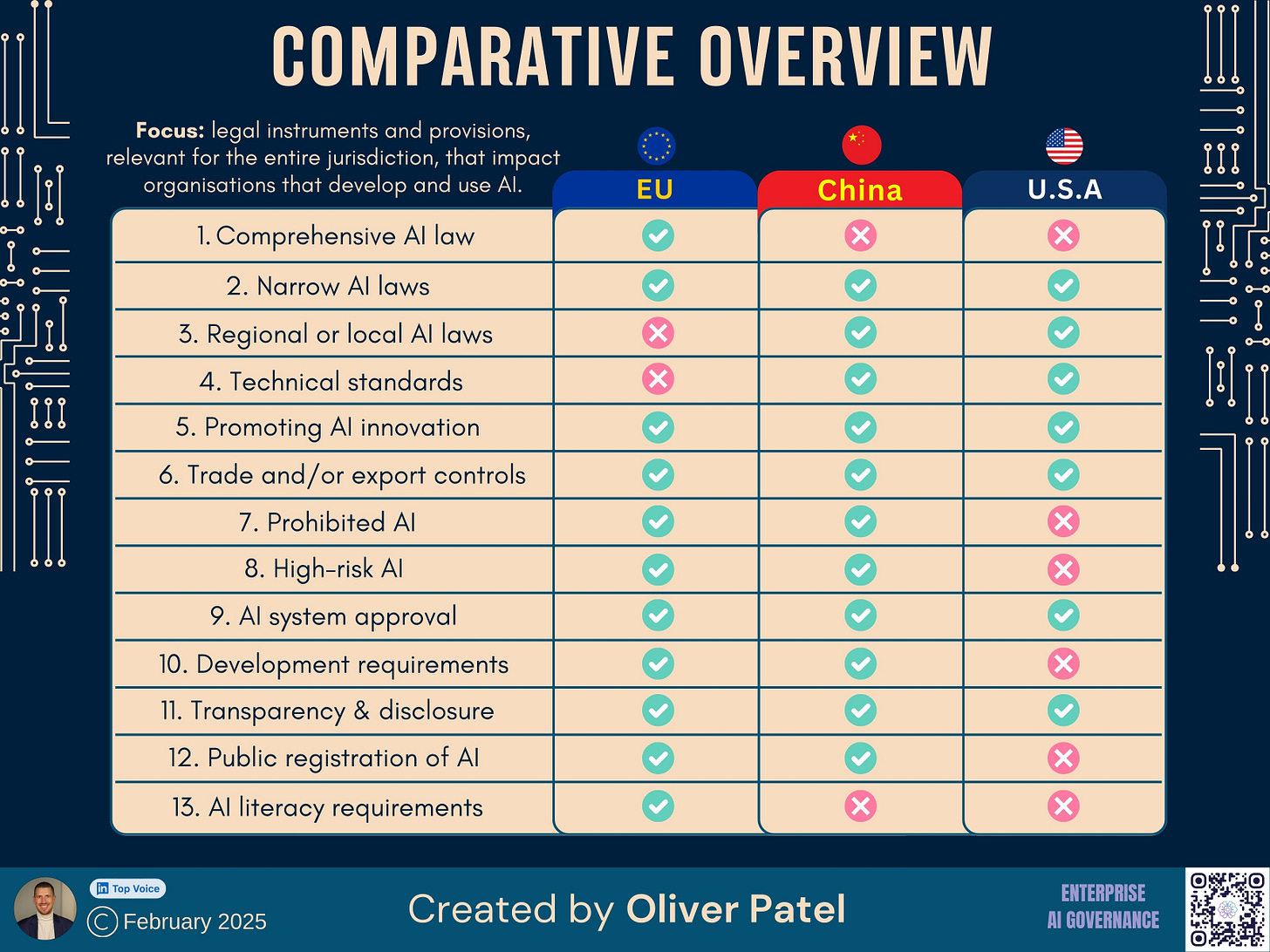Hey 👋
I’m Oliver Patel, author and creator of Enterprise AI Governance.
This free newsletter delivers practical, actionable and timely insights for AI governance professionals.
My goal is simple: to empower you to understand, implement and master AI governance.
If you haven’t already, sign up below and share it with your colleagues. Thank you!
For more frequent updates, be sure to follow me on LinkedIn.
Exclusive subscriber giveaway 🎉
The Global AI Law Snapshot is an in-depth, comparative analysis of AI laws in the EU, China and the U.S.A. It compares and contrasts the relevant laws and their key requirements across 13 critical themes. The themes include regional AI laws, export controls, prohibited AI and AI literacy.
The focus of the analysis is on legal instruments and provisions, relevant for the entire jurisdiction, impacting companies that develop and use AI.
Get the full 17-page report 👇🏼
The sneak preview shows you everything you will get by downloading the report, which covers 13 critical themes in-depth, in a visually engaging breakdown.
Navigating cross-jurisdictional AI compliance
Cross-jurisdictional AI compliance presents a significant challenge for multinational enterprises. While we all want to do the right thing, our companies and teams face a complex and daunting landscape filled with thousands of laws, regulations, and standards.
Many of these are overlapping, duplicative, or even contradictory. Some are ‘existing’ laws in adjacent domains, like privacy and copyright, whereas others are AI-specific laws and standards, like the EU AI Act and the NIST AI Risk Management Framework.
Although this compliance challenge is nothing new, it is becoming increasingly pertinent in the AI era. Not least because AI is a general-purpose technology, used across every sphere of activity, posing both great opportunity and serious risk.
Global businesses face tough dilemmas, such as how to capitalise on advantageous regulatory environments in specific countries or regions, whilst embedding a global governance framework that is coherent, consistent and manageable. The latter point is key because it is ineffective and inefficient for a global organisation to have a different AI governance framework in each market. But the former can only be achieved if that framework is flexible, adaptable and responsive.
Luckily, there are a few principles you can follow to overcome the challenge of cross-jurisdictional AI compliance.
First, stick to the fundamentals and don’t drown in all the noise, because there is more that unites than divides the myriad AI laws and standards. Second, where feasible, apply the highest standards across the board to protect your business and the customers you serve. Third, build bespoke and tailor AI governance to the context, values and needs of your organisation, and pay close attention to relevant sector-specific laws. Fourth, focus on your key jurisdictions, but pay attention to important local differences, which will be relevant depending on your global footprint.
For many readers of Enterprise AI Governance, the key jurisdictions are the EU, China and the U.S.A. This is why these are the focus of my Global AI Law Snapshot. Let me know what else you want me to cover in future!
The first step in addressing the challenge of cross-jurisdictional AI compliance is understanding what the legal regimes in these key jurisdictions consist of and how they differ from each other.
A key takeaway is that the EU and China have been much more active than the U.S.A in regulating AI. In lieu of federal AI laws, there is a complex patchwork of state AI laws. This trend is set to accelerate with the new U.S. administration prioritising deregulation.
However, although the EU and China both share green ticks in many columns in my Snapshot, this doesn’t mean they are following a similar approach. For example, the EU’s comprehensive AI law, the EU AI Act, remains unique worldwide. Whereas China has focused its efforts on specific domains, like generative AI.
Moreover, the ultimate policy objectives of the EU and Chinese AI governance regimes are in contrast. While the EU is heavily focused on protecting people from a broad range of potential harms and risks that can arise from the use of AI, China’s laws are heavily focused on controlling and restricting what information and content is created, shared and published within the nation.
The Comparative Overview (below) offers a high-level summary of the report’s findings.









Great work, thank you!